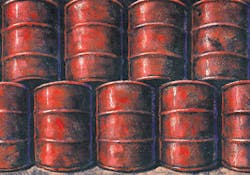The biggest issue is its “ability to make the investments we need to make, so we’ll have the supplies we need,” emphasizes Rayola Dougher, senior economic adviser with the American Petroleum Institute (API, www.api.org), a Washington, D.C.-based trade organization. “But we’re going to need political support from the [U.S.] president and Congress.”One potential and damaging obstacle, she asserts, will arise if the new administration changes the prohibition on off-shore drilling to a distance of 50 miles from U.S. coastlines from the current three-mile limit. “Ninety percent of West Coast reserves would be excluded, and 33 percent of Atlantic reserves would be excluded.”Making better use of its infrastructure also concerns industry, suggests Mike Strathman, vice president for exploration and production in the marketing group with Burlington, Mass.-based Aspen Technology Inc., a provider of process-industries software and hardware services. “A highly unique (and profitable) trend for the energy industry is the integration of surface and subsurface ‘systems’ (i.e., people, processes and technology) via process simulation models to optimize oil and gas assets (i.e., drilling platforms, pipelines and the like).”What does this innovation mean now for the industry? For the first time, users have a multi-purpose, high-fidelity model with auto-calibration mechanisms, he explains. “The advantage is that the same model, tuned to plant conditions, can be extrapolated to new operating conditions.” Thus, the tuned model can monitor plant equipment performance, while performing off-line studies for potential upgrading schemes, different feed/economic conditions and optimization, Strathman adds. Additionally, optimization scenarios can be set to view the asset's entire performance, or can be restricted to certain subsystems, providing workflow that’s aligned with operating decision making, he remarks.Decision-making also includes protecting information technology (IT) assets. That’s why the API held its 3rd Annual IT security conference in Houston on Nov. 11-12 last year. “Topics that will continue to be of interest are SCADA [supervisory control and data acquisition] and process control systems security, emerging IT threats and business continuity efforts,” notes Lisa Soda, API security associate. “The biggest reason has to do with the fact that the threat is constantly changing.” As technology advances, older technologies become vulnerable to exploitation, simply because they have been around longer and bad actors have had the opportunity to find their weaknesses, she comments.Risk management
“IT management concerns continue to teeter on the scale of risk and adequate protection,” Soda observes. “I’m suggesting that when companies are making their decisions to invest in security protections, they base their decisions on a risk-management approach rather than, say, a return-on-investment approach.”Adequate protections also include industry-wide standards that end-users deem necessary. Three just entered the review process this past fall: refinery control valves; fired heater and steam generators; and process-measurement instrumentation, states Gordon Robertson, API senior standards associate. The instrumentation standard must be withdrawn or revised, according to API rules, because it has existed for seven years, he explains.To optimize assets, API has two new instrumentation-related standards: process control-systems design and project-execution-and-process-control-systems ownership. The former gives end-users the ability to have one implementation—or “interchangeability” of controls, Robertson acknowledges. The latter provides a guide to “how to select and design the installation for hardware and software.”C. Kenna Amos, [email protected], is an Automation World Contributing Editor.American Petroleum Institutewww.api.org
“IT management concerns continue to teeter on the scale of risk and adequate protection,” Soda observes. “I’m suggesting that when companies are making their decisions to invest in security protections, they base their decisions on a risk-management approach rather than, say, a return-on-investment approach.”Adequate protections also include industry-wide standards that end-users deem necessary. Three just entered the review process this past fall: refinery control valves; fired heater and steam generators; and process-measurement instrumentation, states Gordon Robertson, API senior standards associate. The instrumentation standard must be withdrawn or revised, according to API rules, because it has existed for seven years, he explains.To optimize assets, API has two new instrumentation-related standards: process control-systems design and project-execution-and-process-control-systems ownership. The former gives end-users the ability to have one implementation—or “interchangeability” of controls, Robertson acknowledges. The latter provides a guide to “how to select and design the installation for hardware and software.”C. Kenna Amos, [email protected], is an Automation World Contributing Editor.American Petroleum Institutewww.api.org
About the Author
C. Kenna Amos
Contributing Editor
Sign up for our eNewsletters
Get the latest news and updates

Leaders relevant to this article:
